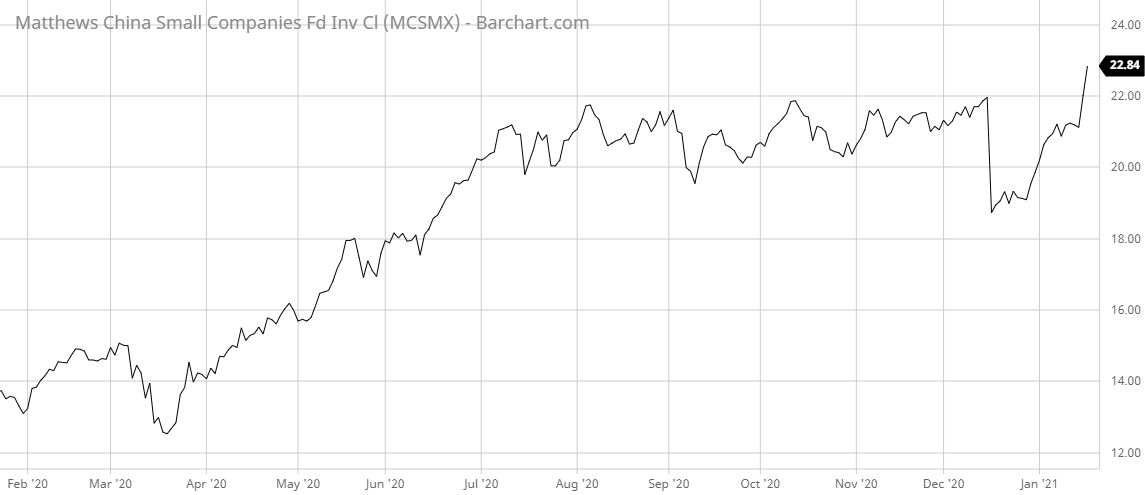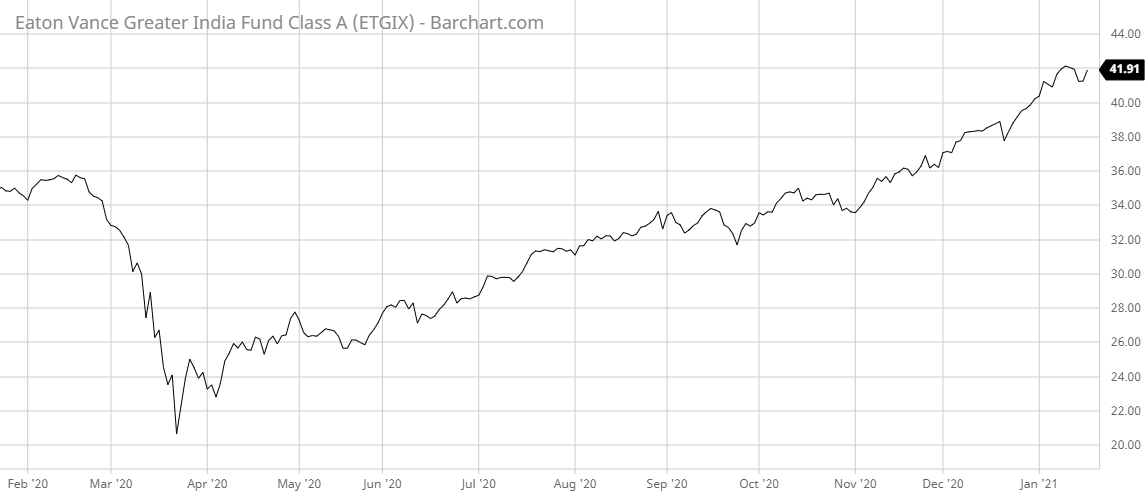First, we select the top trending category from more than 200 categories listed on MutualFunds.com based on the percentage increase in monthly viewership. From the top trending category, we select the top three funds with the highest one-year trailing total returns. To ensure the quality and staying power of funds, we only look at those mutual funds with a minimum of $200 million in assets and a track record of at least 1 year. We also remove those mutual funds that are closed to new investors and are not available for investment outside registered accounts such as retirement or 529 accounts.
In this week’s edition, we analyze the top three Emerging Markets Equity Funds. These funds specifically invest in emerging market economies with the largest being China and India.
As opposed to developed markets like the United States or Japan, emerging economies are in the process of meeting the standards of a developed market but may lack certain regulatory standards, be less liquid, and generally have higher risks for investors. Emerging market equity funds tend to do well when the value of the US dollar is trending on the lower side or is volatile. With US interest rates stagnating and the promise of a stimulus package to increase liquidity in the markets, the US dollar may be in for a more tumultuous future, giving emerging market funds an opportunity for outsized gains.
Our breakdown of each fund includes key aspects such as 1-year performance, fund expenses, investment style, and management teams to give you an overview of how these funds hold up against their peers.
Be sure to check out the Emerging Markets Equity Funds page to find out more about the other funds in this category as well.
Trending Funds
1. Matthews China Small Companies Fund (MCSMX)
The top fund in our list this week is the Matthews China Small Companies fund (MCSMX). It has a stellar trailing 1-year total return of nearly 84%. The net expense ratio of 1.38% makes its fees average compared to similar fund types.
The investment strategy of the fund is to invest at least 80% of its assets in companies that derive the majority of their income from operations in China. Stock selection is made within those listed on the MSCI China Small Cap Index with no company having a market cap greater than $3.07 billion. It uses the MSCI China Small Cap Index as its benchmark portfolio.
The fund is co-managed by Andrew Mattock, CFA, Portfolio Manager at Matthews Asia, and Winnie Chwang, Portfolio Manager at Matthews Asia. They have been managing the fund since August 2020.
The fund’s portfolio currently holds 58 assets, with the top five sector weights in information technology (25.4%), industrials (22.8%), health care (11.8%), consumer discretionary (11.7%), and real estate (8.1%). The top five holdings include SITC International Holdings Co., Ltd.; Weimob, Inc.; Bilibili, Inc.; Silergy Corp.; and Ever Sunshine Lifestyle Services Group, Ltd.
Learn more about different Portfolio Management concepts here.

2. Morgan Stanley Institutional Asia Opportunity A Fund (MSAUX)
The number two fund on our list this week is the Morgan Stanley Asia Opportunity Fund, (MSAUX). The fund delivered a solid trailing 1-year total return of 49.31%. It comes with a slightly lower-than-average 1.45% expense ratio.
The investment strategy of the fund is to use a bottom-up, value stock selection process to invest in securities listed in the MSCI All Country Asia ex Japan Index. It uses the same index as its benchmark portfolio as well.
The fund’s primary portfolio manager is Kristian Heugh, CFA, Head of the Global Opportunity team, who has been managing the fund since December 2015. He is supported by Anil Agarwal, who joined the team in April 2020.
The portfolio of the fund is invested in Asian markets with the regional weights listed as 57.22% China, 17.94% India, 7.43% Taiwan, 4.44% South Korea, and 4.38% Hong Kong.The top five sector weights are consumer discretionary (30.79%), financials (22.04%), consumer staples (17.75%), communication services (12.79%), and information technology (6.02%).
Find out the funds suitable for your portfolio by using our free Screener.

3. Eaton Vance Greater India A Fund (ETGIX)
Bringing up third place in our list this week is the Greater India A Fund by Eaton Vance (ETGIX). It generated a solid trailing 1-year total return of 20.31%. It has a net expense ratio of 1.62%, making it the most expensive fund on this week’s list.
The fund’s investment strategy is listed as investing at least 80% of its assets in companies located in India, Pakistan, or Sri Lanka, with no more than 10% allocated regions outside of the Indian subcontinent. It is benchmarked to the MSCI India Index.
The primary portfolio manager of the fund is Hiren Dasani, CFA, co-head of emerging markets equity at Goldman Sachs Asset Management, L.P., an Eaton Vance subadvisor. He has been managing the fund since May 2017.
The fund’s portfolio contains 45 assets, with the top five holdings listed as Infosys Ltd (13.84%), ICICI Bank Ltd (8.47%), Reliance Industries Ltd (8.21%), Axis Bank Ltd (5.80%), and Hindustan Unilever Ltd (4.75%).
Want to know more about portfolio rebalancing? Click here.

The Bottom Line
Make sure to visit our News section to catch up with the latest news about mutual fund performance.
Note: Data as of January 14, 2021.

